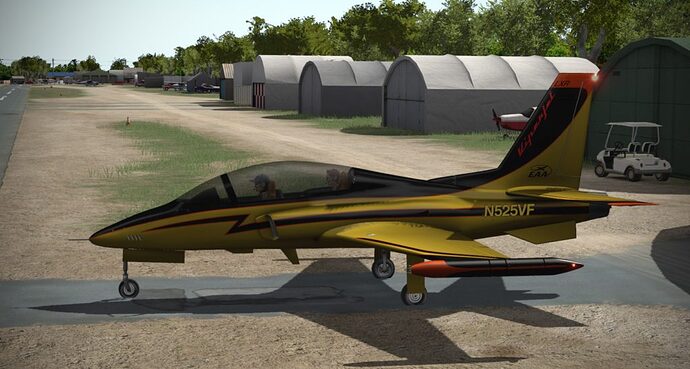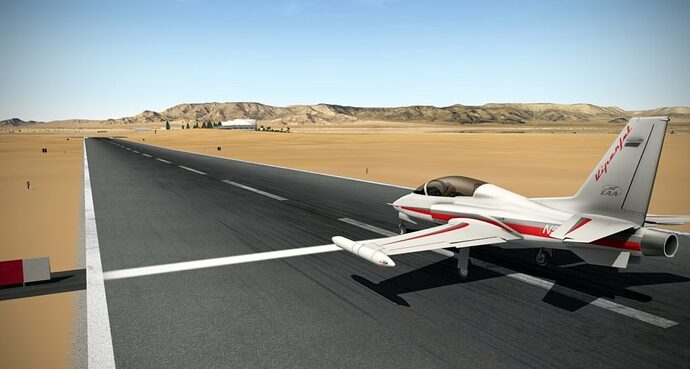Aerobask ViperJet LXR
By @BeachAV8R - September 13, 2016
Originally published at: Articles - Mudspike Forums
The ViperJet LXR for X-Plane is a snappy, fun, personal jet that can be used for cross country flying, shooting instrument approaches, as well as flying aerobatics.

One of the fun things about X-Plane, and a characteristic of the users and developers that create content for it, is that we often get to see some interesting aircraft, scenery, and utilities that tickle our curiosity. When I first spied the Aerobask ViperJet LXR at the X-Plane.org store, I knew I had to buy it. Released about a year ago (remember – we aren’t the first with information..just the best..!) the ViperJet LXR is Aerobask’s take on the kit aircraft that ambitious homebuilders can construct in their garage, or they can take advantage of a builder assistance program to help them with the construction. The base kit costs around $182,000 (2006 figure) but additional components typically drove the cost to closer to $350,000. The Aerobask ViperJet features a pressurized tandem cockpit and tip tanks that stretch the range to 1450nm. The 3D model is beautiful, but isn’t perfect, with a bit of strangeness going on from the dead-on rear view with some gaps between the fuselage and the engine..but that is rarely seen.
Selection switches in the cockpit allow you to select a GPU, and remove pitot covers, chocks, and engine covers. The startup sound as the ignition brings the single Pratt & Whitney JT15D-1A to life is really cool with a deep, throaty groan building to a steady whine.
Jumping in the cockpit, we find a beautiful, clean and modern panel with a very pleasing arrangement of displays and avionics. Hitting the GPU switch connects power to the avionics and after a brief initialization phase the instruments come to life. The layout consists of an Electronics International MVP-50 engine and systems monitor on the left side of the panel, a Garmin GDU-370 Primary Flight Display (PFD) in the center, and a Garmin GNS 530 GPS on the right side. Additional components include a Garmin SL 30 NAV/COM head, a Garmin GMA 240 audio panel, a Meggitt autopilot control panel, and a Garmin GTX 330 transponder. The crispness of the panel graphics is fantastic, but you have to believe this is a factory fresh aircraft since the panel is pristine.
In addition to engine and systems information, the MVP-50 has a convenient page that allows for fuel filling, fuel dumping, and includes fuel level, flow, and distance predictions. The default page shows a wealth of information including N1, ITT, N2, EGT, fuel and oil pressure, oil temperature, fuel quantity in the four tanks, fuel flow, G-meter, time, system voltage, amps, and outside air temperature.
Additional aircraft settings can be selected from the MENU page of the Garmin GDU-370 – allowing the selection of weather radar, glass reflections, barometric pressure units, voice alerts, and temperature units.
The canopy reflections are a really nice touch (as well as the raindrops in this screen), but they are not dynamic in that they don’t truly reflect the readings of the instruments, but the effect is quite good regardless.
The aft cockpit is arranged with more compact instrumentation – a nice feature considering the developer could have just duplicated the forward cockpit. A Mid-Continent MD-302 Standby Attitude Module provides an ADI, airspeed, and altitude tape, while a Universal EFI-550 HSI provides compass and course guidance. A second Meggitt autopilot controller is mounted below the MD-302 while another MVP-50 and GNS 530 are mounted lower on the panel, giving the aft cockpit full functionality.
Startup is a straightforward affair with less than ten steps to get the Viper up and running. The three position flaps can be positioned to the middle position for takeoff, and the canopy should be shut and pressurization turned on. Various systems include fuel tank transfer pumps, bleed air, electrical, and anti-ice. Fuel load can be adjusted via the MVP-50 MENU page with a requirement that the tip tanks be empty if aerobatic flight is planned (they can also be dumped in flight). Acceleration on takeoff is swift, with rotation occurring at 85-90 knots. Be mindful of the engine ITT limit of 720°C or a warning light will illuminate on the MVP-50. Takeoff distance is around 1,500′ which bore out in testing, variable (of course) according to weight. The short takeoff and landing performance makes the ViperJet a viable option for even the smallest general aviation airports. Taking advantage of my new KMUD custom scenery (sorry – not yet available!) – I did some testing with my marked 4,000′ STOL runway. I did some brake release to 35′ measurements, and 50′ to end of the landing roll and came out with these measurements:
- MTOW T/O – 1,900′
- MTOW Landing – 1,700′
- 200 lbs. payload, 30 min fuel weight T/O – 1,200′
- 200 lbs. payload, 30 min fuel weight Landing – 1,200′
There are no thrust reversers or attenuators, just brakes and speedbrakes for stopping.
Comparative landing distances at maximum and near minimum landing weights. A closer look at the MVP-50 with engine and system parameters…The flight model seems good. I’m not too sure on real world specifics but at max-gross, time to climb to FL250 at 200 knots was just a touch over 10 minutes. Manufacturer advertised climb rates are between 6 to 8,000 feet per minute, likely at lighter weights. With just 500 lbs. of fuel onboard, a 5,000 fpm rate was observed to 10,000′. True airspeed at FL250 settled in at 410 knots (Mach .71) and a fuel flow of 360 lbs./hr. – comparing favorably to the book value of 390 knots. The fuel burn vs. true airspeed calculations bring the range into the 2,000nm area (zero fuel remaining), in line with the manufacturer’s advertised range of 1750nm with a 45 minute reserve. So basically – the numbers seem to check out.
Autopilot functionality, course tracking and intercepting, precision approach tracking, altitude capturing, indicated airspeed hold, vertical speed mode, and all modes of the autopilot are very, very good. This is important, because some X-Plane developers have some pretty sloppy autopilot integration for some reason..but the ViperJet is fairly tight. My only small gripe is the ALT SEL rotary moves in 20′ increments. Personally, I’ve never flown a plane that didn’t use 100′ increments. The 20′ increments mean that it can take a fairly long time to scroll up to the flight levels when making large altitude preselect adjustments. The Garmin GPS is the default X-Plane GNS 530 – capable enough, but not exactly full featured. The data displays, buttons, and overall clarity of the panels and instrumentation is fantastic.
A closeup view of the Garmin GDU-370 Primary Flight Display tracking the ILS to KMUD.Aerobatics are fun in the ViperJet, although it can be pretty forgiving – resisting entries into spins unless pro-spin inputs are held, and quickly exiting the condition when pro-spin inputs are released. Max gross stall speed occurs at 77-80 knots and there is not much roll-off tendency. Angle of attack is readily visible via the Falcon AOA indicator that uses a light bar to indicate AOA throughout maneuvers. Idle power and speedbrakes until meeting the 175 knot gear extension speed will net around 6,000 feet per minute of descent rate with the gear out.
The manual is good enough for the level of simulation in this aircraft, with good instructions on the sim settings, avionics, checklists, and systems, although it could stand to have a bit more depth in the performance aspects such as take-off and landing data and cruise power/fuel consumption charts.
Six nicely detailed liveries are included with the package and an additional four liveries are available from the Aerobask website.
All-in-all, the Aerobask ViperJet is just about in-line with my expectations for the price point. A fun little aircraft, with a nice, modern panel that is useful for some quick and dirty flying when I want to check out a scenery area without having to worry about density altitude or a ten minute startup process. It is also a great “flight check” aircraft for testing out approaches since the instrumentation is so user friendly and precise. I’m going to have to lobby for a Mudspike Flight Test skin now.
Chris “BeachAV8R” Frishmuth
















































